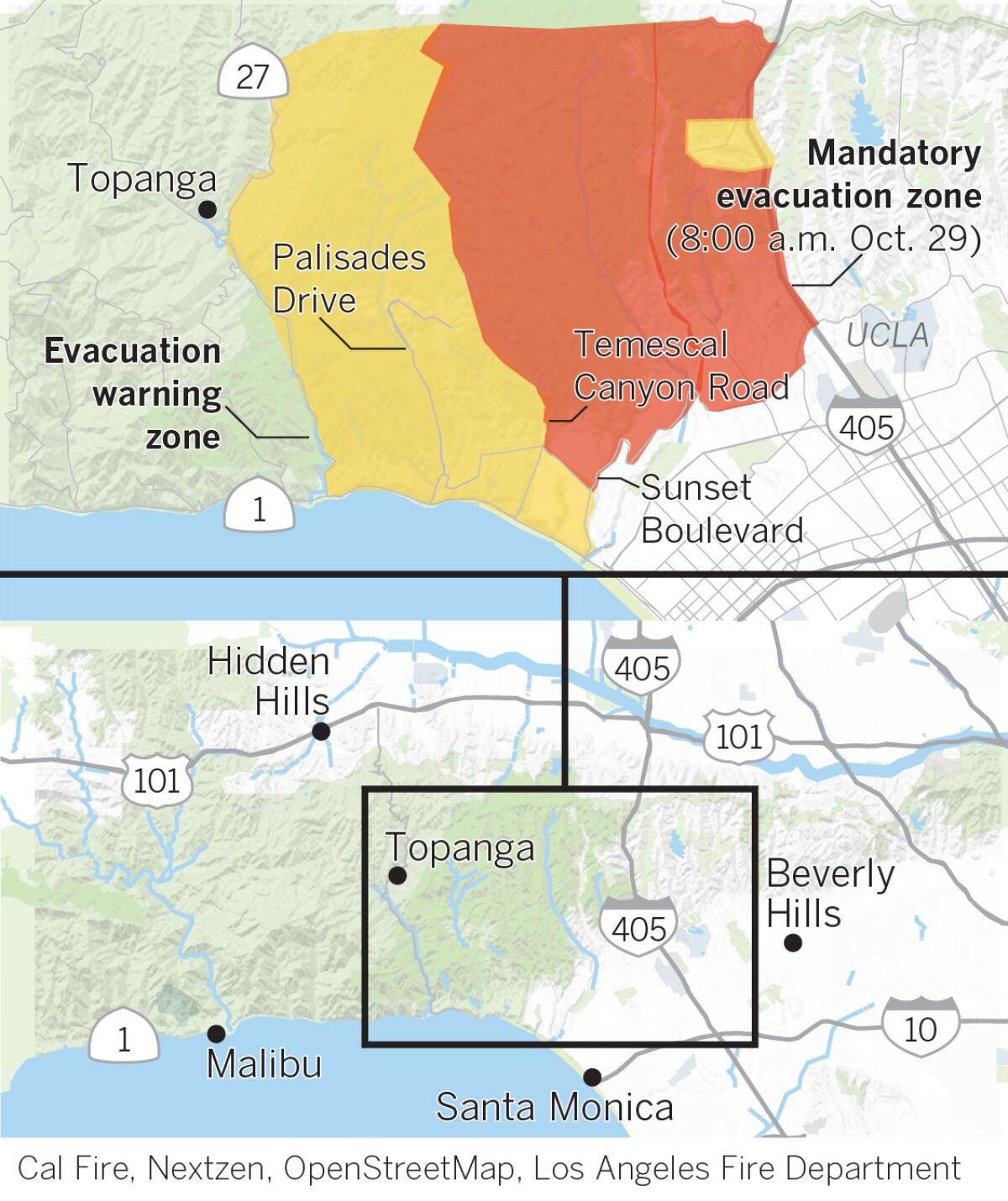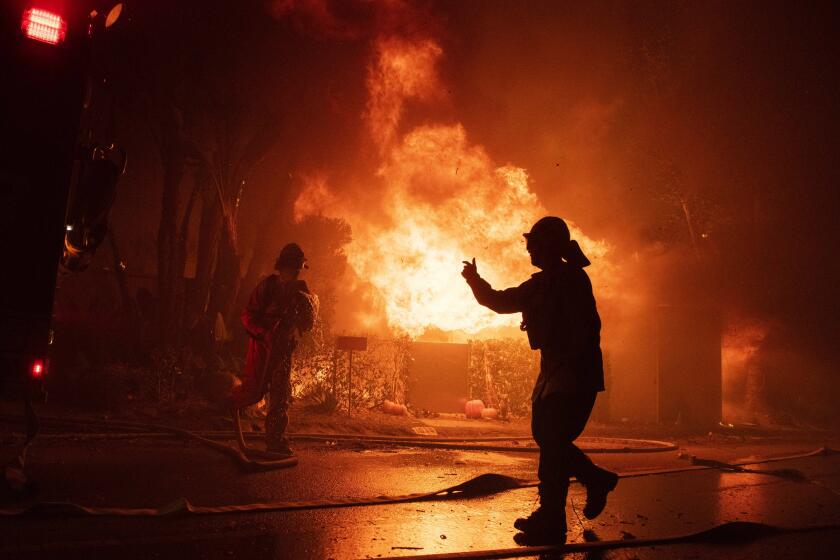Extreme warning issued ahead of brutal Santa Ana winds, the strongest since 2007

- Share via
In an ominous new advisory, the National Weather Service issued a rare “extreme red flag warning” for Southern California through Thursday evening, saying winds could top 80 mph and be the strongest in more than a decade.
“The magnitude of the wind gusts really [is] going to be a concern,” said Daniel Swain, climate scientist with UCLA and the National Center for Atmospheric Research. “The actual winds that people experience really will be quite extreme in a lot of places, really everywhere except for the wind-sheltered parts of downtown L.A. and central L.A.”
The warning has put Southern California officials on edge. The Los Angeles Police Department will be on tactical alert to help with evacuations if needed. The Los Angeles Fire Department is also placing additional resources and extra staff in wildfire-prone areas.
Officials worry the winds could prove disastrous for the smoldering Getty fire, which broke out shortly after 1:30 a.m. Monday along the 405 Freeway near the Getty Center and quickly spread into tony neighborhoods. A day after it sparked, the blaze had charred more than 650 acres, burned several homes and sent thousands of residents fleeing in the dark. The fire was 15% contained as of Tuesday night.
The fire was sparked when a tree branch fell on power lines, Mayor Eric Garcetti announced Tuesday. The power lines are operated by the Los Angeles Department of Water and Power, according to a fire official. The agency said it was cooperating with the investigation.
According to fire officials, 12 homes have been destroyed and five have been damaged in the wind-driven fire. Embers are still flying, which could easily spark brush fires elsewhere.
“All it takes is one ember, one ember to head downwind and start a fire,” Los Angeles Fire Chief Ralph Terrazas said at an afternoon news conference.
Winds are expected to pick up late Tuesday, with peak gusts expected about 3 a.m. and strong, steady winds continuing into Thursday.
A total of 43 counties in California are experiencing red-flag warnings or historic wind events, said Gov. Gavin Newsom, who also attended the news conference. “It’s been a long week,” he said.
Newsom declared a statewide emergency Sunday as wildfires spread throughout the state, burning tens of thousands of acres and forcing evacuations of more than 180,000 people. They include the massive Kincade fire in Northern California, which has destroyed at least 124 structures and threatens an additional 90,000.
Newsom said the federal government has been responsive to the state’s needs. “FEMA has been extraordinary,” he said. “The Trump administration has been extraordinarily supportive and helpful. Every request we have made has been granted.”
“It’s all about mutuality and, dare I say, our humanity,” Newsom said, adding that people aren’t focused on their differences but helping each other.
With about 1,100 firefighters battling the blaze, crews’ main objective Tuesday was to boost containment ahead of the extreme Santa Ana winds set to arrive overnight and into early Wednesday. The gusts are expected to be the worst the region has seen this season, Terrazas said.
Fire officials worry the high winds may blow smoldering embers miles away from the body of the blaze, setting new spot fires in dry brush or igniting homes. “We’re very concerned about tonight’s wind event,” Terrazas said.
In addition, the relative humidity is expected to drop into the single digits and will not recover much overnight, according to fire officials.
“This all adds up to an extreme fire weather threat, meaning that conditions are as dangerous for fire growth and behavior as we have seen in recent history,” the Los Angeles Fire Department said in an update issued Tuesday night.
For that reason, fire officials say mandatory evacuations for thousands of residents — east of Temescal Canyon Road, north of Sunset Boulevard, south of Mulholland Drive and west of the 405 — will remain in effect. More than 7,000 homes are under mandatory evacuation orders, according to the fire department.
Many displaced Angelenos will not be permitted back into their neighborhoods for at least another day, officials said.

Several area schools will remain closed Wednesday due to fire conditions and evacuations.
“I’m sure we’ve all gotten phone calls and had conversations with people saying, ‘Well, there’s not a lot of smoke. It should be fine to go home.’ I want to continue to tell people: Listen to the professionals and the firefighters who are asking you to stay away,” said Garcetti, adding that evacuation centers set up Monday are still open.
“People will not be returning to their homes this evening. You should prepare for that now,” Garcetti said.
The possibility of days away from home proved vexing for those living near the burn area.
Along Sunset Boulevard on Tuesday, most streets leading up to the hillside homes where the Getty fire burned the day before were blocked by parking enforcement officers teamed up with a pair of motorcycle cops. Meanwhile, a long line of cars slowly made their way onto Kenter Avenue, where residents asked officers whether they could return home.
Marinette Simon and her dog, Rusty, were among the dozens of residents who sat in their cars for several minutes, waiting and hoping they would be allowed back in their neighborhood. Most just wanted a few minutes to check on their homes and collect items they wished they had grabbed before being forced to flee flames that threatened to overwhelm their community a day earlier.
Simon wanted to grab her husband’s cholesterol medication, the deed to the house, passports and hard drives for her daughter, but police wouldn’t let her in.
“It’s a little frustrating,” she said.
Residents in the Mountaingate community, however, were allowed to return home Monday night. But officials warned they should be prepared to evacuate again if the fire flares up.
Santa Ana winds blowing between 50 and 70 mph, with isolated gusts up to 80 mph in the Santa Monica and San Gabriel mountains, are expected to arrive late Tuesday and last through Thursday evening, forecasters say. The predicted wind speeds prompted the National Weather Service to warn the public of high potential for “very rapid fire spread, long range spotting and extreme fire behavior with any new fire ignitions.”
“This is the worst since we had an event in October 2007,” National Weather Service meteorologist Tom Fisher said. “Don’t let your guard down.”
During the 2007 weather pattern, a series of fires broke out across Southern California and burned more than 198,000 acres, destroying 1,500 homes, injuring 40 firefighters and causing two deaths. The most significant of those fires was the Witch fire in San Diego County, which ultimately led the region’s major utility to spend about $1.5 billion to update its grid to avoid sparking future fires.
The strong Santa Ana winds are the result of a combination of high pressure and frigid, dry air from Canada.
The clockwise circulation around that high-pressure system drives northeasterly winds over mountain peaks and through narrow passes and canyons, which increases the velocity and dries out the air more. The air is colder and heavier because it originated near the Arctic Circle, so it gains more momentum than in a warmer, offshore wind event.
“When you have cold air, it tends to sink, and when you have winds coming down the mountain, it causes it to accelerate,” said Kristen Stewart, a meteorologist with the National Weather Service in Oxnard.
The arrival of high winds across the state means that more than 2 million Californians could once again lose power amid concerns by utility companies over wind-blown equipment sparking wildfires.
Southern California Edison has already shut off power to more than 100 customers and is monitoring an additional 206,000 customers for possible shut-offs in Kern, Los Angeles, Mono, Orange, Riverside, San Bernardino and Ventura counties in the coming days.
Pacific Gas & Electric Co. announced Tuesday it would shut off power to nearly 600,000 customers in its latest bid to reduce the wildfire risk.
The counties that may be affected by the PG&E shutoff are Alameda, Alpine, Amador, Butte, Calaveras, Contra Costa, El Dorado, Humboldt, Kern, Lake, Marin, Mendocino, Napa, Nevada, Placer, Plumas, San Mateo, Santa Clara, Santa Cruz, Shasta, Sierra, Siskiyou, Solano, Sonoma, Tehama, Trinity, Tuolumne, Yolo and Yuba.
Times graphics and data reporter Paul Duginski contributed to this report.
More to Read
Sign up for Essential California
The most important California stories and recommendations in your inbox every morning.
You may occasionally receive promotional content from the Los Angeles Times.















